Guest Interview n° 35: Zefrey Throwell
Last week we introduced you to the brilliant and controversial Zefrey Throwell and his Ocularpation: Wall Street. Today we present Lane Koivu’s interview of the provocative artist and master of this “Freudian nightmare.”
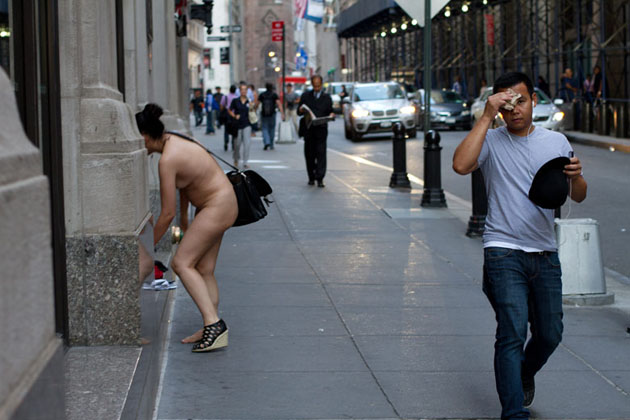
When did you start pursuing art as a way of life?
I was 19. I was mostly into punk rock—loud noisy music. I was in a couple of bands. We weren’t very good. We were very loud though. [Laughs] I had a girlfriend at the time who was a painter. And I remember going over to her garage and she was painting, and I was drunk. And I was giving her shit about what she was painting. I was like, “I could do better than that!” And I remember I picked up an old toilet seat cover that was laying around in her garage, grabbed some of her paint brushes, and started messing around on it. And it was amazing. I totally loved it.
How’d the idea of Ocularpation: Wall Street get cooked up, and why did it happen when it did? I’m interested in why all of these factors came together down on Wall Street, three years after the crash.
The idea came up because my mother was a high school counselor for thirty years—a public servant. She was working hard, putting her money away. She really saved a lot, and then retired. It’s the classic American ideal: work hard, put the money away because nobody is going to take care of you, you take care of yourself, and you’ll be able to enjoy your golden years in Florida, or wherever the hell you want.
So she does this, she follows the law, and was retired for three days when the market crashes and she loses the majority of her life savings. Within a day and a half. It was a massive bleeding. She was stunned at first, then depressed, then really depressed and sad. Not only did she lose all of this money, but she was going to have to come out of retirement. And by this time the place she’d left didn’t want to hire her back, because she’s old, already in her 60s. And other places aren’t looking to hire public counselors in their 60s—they’re looking to hire young people that get paid half as much. So she had a hell of a time getting a job for years. Nobody wanted to hire her, she’d get more and more depressed and would cry over the phone. Which you know, if you’ve ever heard your mother crying over the phone, it’s fucking horrible. Especially when there’s nothing you can do.
So I came up with this project as a way to really re-focus media attention on Wall Street and what was happening down there. It’s hard to imagine now, but before Occupy moved in, and before my performance, no one was talking about Wall Street, right?
Right.
Right. And in fact the week before I did this performance, the NY Times wrote an article called “Wall Street’s Got it’s Swagger Back.” It was all about how bonuses were bigger than ever down on Wall Street—bigger than before the crash—and my mother would see things like this and it would driver her insane, because all of her money was gone. It’d been siphoned into this giant money machine. So it was in the context of this massive inequality that was happening that I came up with the project. I wanted to refocus a lot of attention on Wall Street. And it worked like crazy.
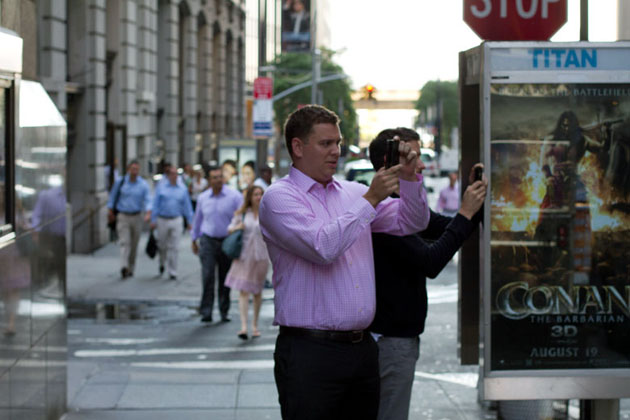
It was the most successful piece you’ve ever done?
As far as media attention, absolutely. I mean, six months later NY1 is interviewing me, you know? It’s going to be on the news in a couple of days. Still! And it happened back in August.
Do you think the Occupy movement would have happened without Ocularpation?
I really can’t say. The interactions I’ve had with people down at Occupy are normal people like you and me. For a large group of strangers in New York—where we tend to talk more about rampant consumerism in our day-to-day lives—to be talking about how they can reshape the government, it’s fucking great.
Tell me about “I’ll Raise You One…” that you did last November at 79 Walker Street.
That was a seven day performance. By contrast, Ocularpation was five minutes. This was seven days and we were in there nine hours a day. We were trying to explore different economic models, but to do it in a way that wasn’t stale and boring. Because when we talk about economics, especially in the US, it’s with techniques that have been used since the 60s or before: sit-ins, massive protests, stuff like that. The formats tend to lose their edge because they’re old. And I’m not interested in that. I’m interested in catching people’s attention in a fresh way. So in that brief window when you actually get someone’s attention you can bring your point home, let it germinate, and then it can take on a life of its own.
Through the shock value of nudity?
Nudity, or through games like strip poker, where people might think, “Oh, I remember playing that as a teenager.” So we set up a table and had different participants rotating each day. We tried out five different economic models. The first one was capitalism—unregulated wealth, free market. People showed up with however many layers they wanted to bring, which is kind of how life is. People have different amounts of money but have to play by the same rules.
Except people don’t get to choose how much money they start out with in real life.
Right, but here people were given simple instructions: Just wear clothes. One guy showed up with like 100 layers on. He had trouble breathing. We had to take some clothes off for him. There was like six inches worth of teachers. And then other people showed up in only a sweater.
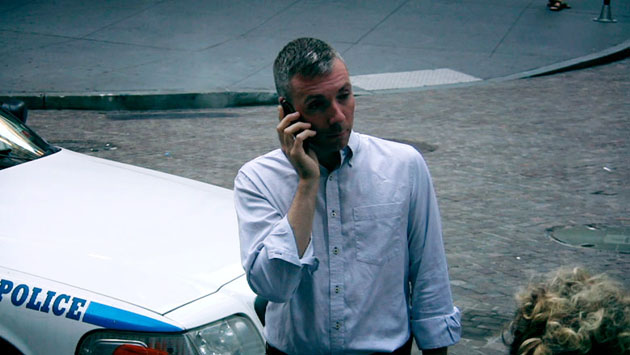
You talked about the shock value of using nudity as a means to get people’s attention. Now that you’ve garnered so much publicity for doing these flash projects, are you weary or afraid of being pegged as “the nude artist”?
Yes. It already is very much that people have pigeonholed me. You do something a couple of times—not to mention the fact that I’ve done many, many other projects in the meantime. I’ve made a feature-length movie, I’ve done the Midtown games where we had 100 people running a 250-meter relay race in Times Square, everybody with their clothes on. Because people have already associated me with nudity, they try to peg me as a “naked artist”.
How do you feel about that?
[Laughs] Well I’m definitely not doing any nudity for a while.
What about your new project? Can you talk about that a bit?
It’s called “Entropy Symphony Movement III Los Angeles”. It’s the third part of a continuing symphony I’ve done. And it’s going to be 1,000 car horn symphony in LA played all across the city. Not all bunched together. Some in the south, some in Venice, some in Silver Lake—they’re all over the place. Beeping out a five part symphony. I have big list of all the different horn sounds, and if you have a certain car model you’ll get a certain sound. And from 6pm to 6:05 they’ll get an MP3 with their part on it, and then play along with their horns. Ba bap bap baaa! Unlike most projects, no one can experience this at all until afterwards. It’s what I call “a Fireside Method”, where everyone comes around the campfire and tells the story. And that way it creates the whole.
“The Fireside Method” was also used for Ocuparlation. Everyone had a different take—especially the three people who got arrested.
Sure, those guys in particular. Because inside there are some of the largest criminals that have ever walked the earth. Economic thievery of the kind that we have never seen before. The kind that has crushed worlds. Entire nations have been destroyed by what happens in that building. And then three kids take their clothes off in front of it and get arrested while everyone inside gets off scot-free…
There’s the obvious irony, but you seem to look at it with this hilarious, absurd perspective. Not cheeky, but most of your projects take on heavy subjects with a sense of playfulness, almost an innocent rebelliousness to them. And they walk a find line between authority and rebellion.
Thank you. My favorite artist is Andy Kaufman. That’s who I try to emulate. His most famous thing was probably…wrestling with women, maybe? Maybe lip-syncing Mighty Mouse? [Laughter]
How important is a sense of humor for you?
I try it with everything. If you think of any arty events—museums, galleries, what have you—they’re almost always devoid of humor. And if there’s humor, it’s insular academic humor that’s just so nauseating.
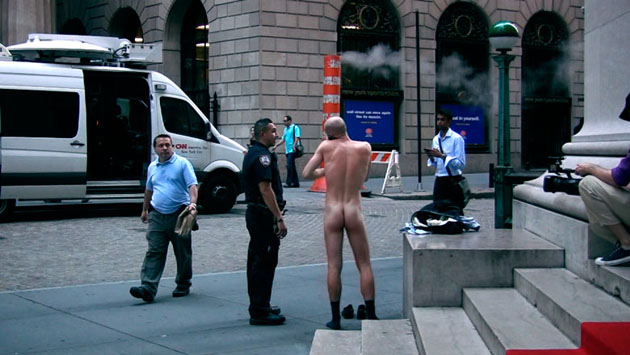
That reminds me of another project of yours, “New York Paints Better Than Me,” which I thought was hilarious. Was that your aim?
[Laughs] I got to this point where I was having a real problem painting. I’d painted for years, and it just really seemed to bottom out on me. It just seemed that the things I was making weren’t very good. And then I was walking around one day and I realized that New York is the most diverse city in the world, filled with enclaves of culture, also must have the most diverse trash in the world. So this trash lying everywhere, that’s the most diverse palette in the world. I couldn’t mix those colors up, you know—these colors don’t run! [Laughs]
But if you look out there it’s all piss, it’s all shit, cigarette ash, slurpee, chicken bones. All over. Human skin dust. Everywhere. So this idea of dragging myself as a way to take a swab sample of the free public parks. I’ve only done two so far, and then I kind of hurt my shoulder, which is slowing me down. It’s a continuing project.
I saw a video of you crawling through Washington Square Park and couldn’t help but imagine what these poor pedestrians were thinking!
Well the public is very savvy. It’s something I forget, something I think people often discount. The public really knows what the fuck is going on. At first a few people will be like, “Hey buddy, get up! What the fuck are you doing!” And then after a second, “Oh, uh oh, this is some kind of art thing! We’re probably on YouTube right now.” But overall it’s pretty hilarious. I had this one guy who had his dog run on me. That was funny. It’s not ok if I’m standing up, but if I’m laying down the dog can run on me.
What’s the suit look like afterwards?
After Union Square it was almost black. Times Square is next, and I think that might be a little dirtier.
How important is that unfiltered public reaction to your work?
Well I appreciate the idea that art can be more engaging than what museums and galleries have right now. We’re in a gallery in Chelsea—we’re in the heart of the art world; people from all over the world come to see contemporary art right here. Granted, we’re in a smaller gallery now, but across the street is the second largest gallery in the world. They’ve seen maybe 100 people in the last couple of hours. If you do a project in Union Square there’s thousands of people within minutes.
And they’re not part of that world, either.
Right. They’re participating in something. It feels alive to them.
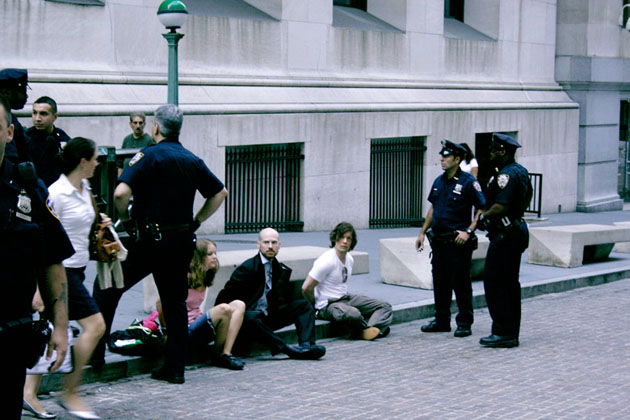
You referenced a John Cage quote that seems to run a fine thread through all of your work: “Comfort is not your friend.” And one of your more recent projects, “Take All of Me, New York,” embodies that completely. Tell me about it.
Yeah, I moved every month for a year. To a different neighborhood in a different borough each month.
What were some of the more interesting places you’ve lived in?
I lived with a prostitute in Hunt’s Point. I lived on a boat in Sheepshead Bay. I lived with an old, old man in deep Queens who was a total shut-in. He goes to Dunkin’ Donuts once a day. I lived with a Chinese family in Chinatown. They barely spoke any English and certainly didn’t give a flying fuck what kind of project I was doing. They just wanted a check.
Have you ever found yourself in danger?
Other than in jail?
It seems like going to jail would be considered a success!
Well, if I’m on point then I’m probably running into the law.
You’re very good at getting people to pay attention. But do you ever worry that these tactics get in the way of whatever it is you’re trying to convey?
I don’t know. As I said before, I think people are very intuitive and really do know what the deal is. Sure, there are some creeps, [especially with the “I’ll Raise You One…” nude poker piece.] But most people are very excited, stop to take pictures, ask what the deal is.
The craziest part was this man named Corey who would hang out everyday. And at first he was kind of a lurker. But a couple days into it he really took ownership in the project and would explain to people who were seeing the show for the first time. If somebody would start tapping on the window he’d step in and say, “None of that, it’s an art project!” Random man on the street claiming ownership. It was great.
Lane Koivu – Image courtesy of Zefrey Throwell
